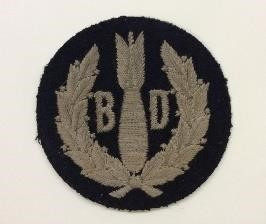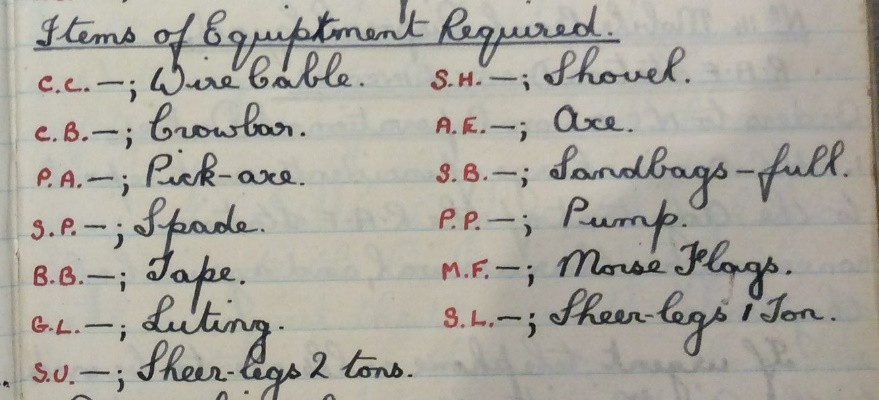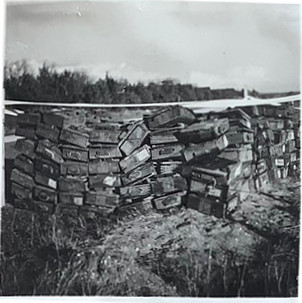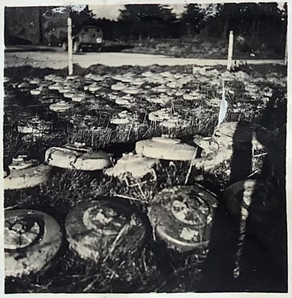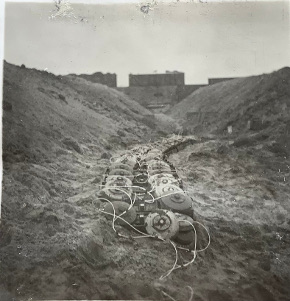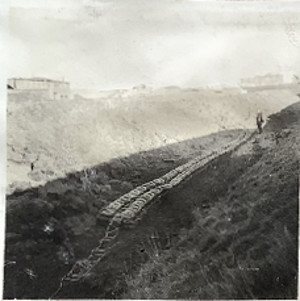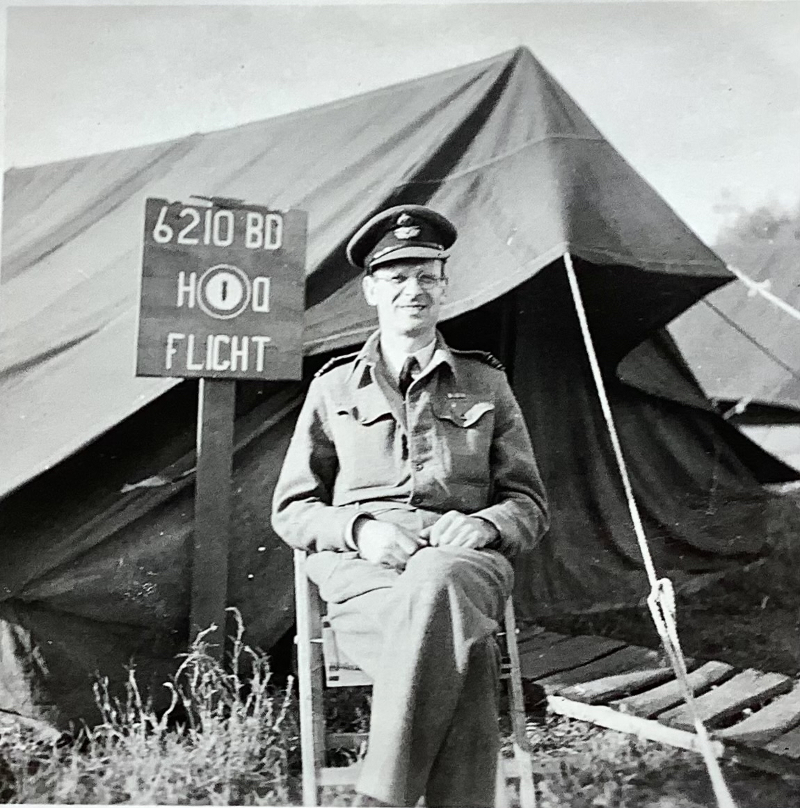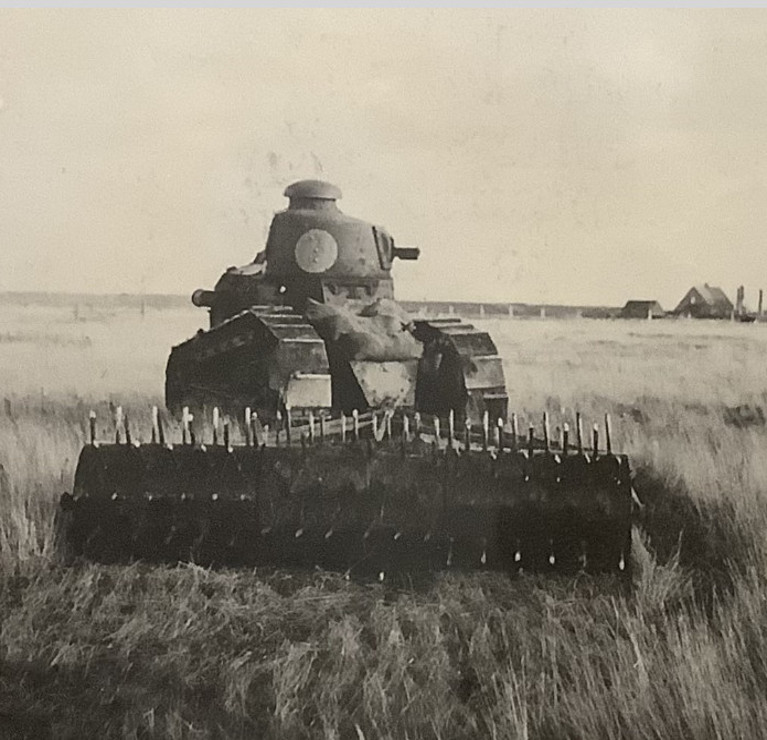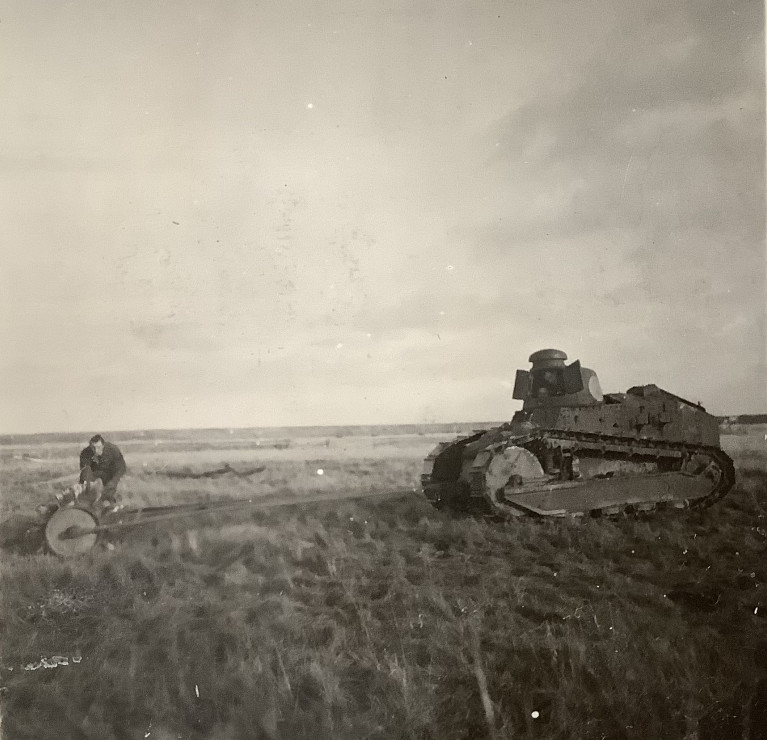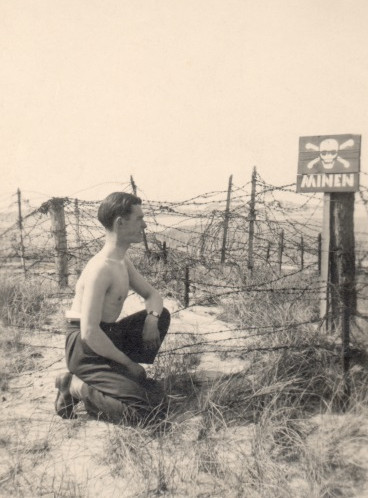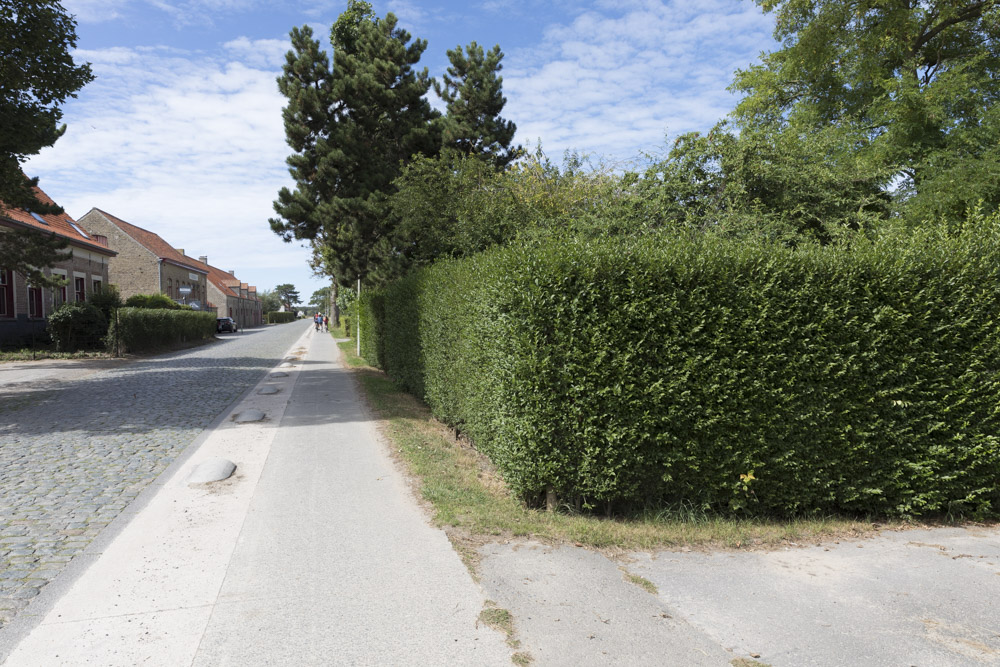Introduction
In 2019, TracesOfWar received the war diary of Sergeant Roy Tull. His daughter, Mrs. Barbara Kelly, provided us with the contents and gave us permission to post it on the website. The diary describes the work and journey of the RAF Bomb Disposal Squad from Normandy into Germany.
However, that was not the end of Barbara Kelly's input. She learned more about the said Bomb Disposal Squad through further research. Very specifically about the operations in the winter and spring of 1944 and 1945 at ALG B-83, the Abandoned Forgotten & Little Known airfield near Knokke (Belgium), also known as Knokke- 't Zoute.
Definitielijst
- RAF
- Royal Air Force. British air force
Further research
She tells us that her further research revealed that The RAF Airfield Construction Squadron relaid three runways early in 1945. It would appear that the RAF 142 Wing (who were flying coastal patrols) were working along that coastline hunting for mini submarines.
Dad mentions several of these being spotted/eliminated and it is possible that he had direct contact with the pilots if they were using ALG B-83 as a base. I have no firm evidence about this, just that Dad was in 142 Wing and that he mentions the coastal patrols with information about their activities that I haven't seen elsewhere - noted in his diary.
* Read also: the experiences of Roy Tull*

A cutaway from the captured German plan of the minefields around Knokke. The airfield is on the Odette minefield. Source: Vafadari family (donated to For Freedom Museum)
ALG B-83 was heavily mined with Teller, wooden Shü-mines (Schützenmine), ‘S’ mines and Holtzmines. Some of these had been laid in marshland and sandy soil and were extremely unstable because of deterioration. Because of the density of mines the airfield had to be divided into long breaches or panels for demining purposes, sometimes extending over 500 yards: these breaches were marked by white safety tape. Within these breaches were belts of Holtz, ‘S’, Shu and Tellermines which had been laid in long lines with similar devices together. Signalling codes were sent via Semaphore, if equipment was required or warning of imminent explosions etc. see below.
There was also a British Army bomb disposal training school for Belgium and French officers, a bomb museum, RAF Regiment squads who manned the ak-ak guns and of course the RAF BD teams who were still working their way along the German Atlantic Wall defences taking out mines and booby traps - they also were engaged in demining the beach.
Of particular significance is the fact that the airfield was used both as a bomb dump and a collecting point for German and Allied munitions from the surrounding area - munitions were either taken from there up to the Belgium Bomb Dump at Eecloo or shipped back to the UK for further investigation.
Definitielijst
- RAF
- Royal Air Force. British air force
- Regiment
- Part of a division. A division divided into a number of regiments. In the army traditionally the name of the major organised unit of one type of weapon.
- Squadron
- A military unit in the Belgian navy usually six to eight small ships operating together under one command. The smallest military unit in the Dutch air force of about 350 men. In most countries is the designation of a military unit thesize of a company. It is either an independent unit, such as a battery, or part of a bigger Calvary unit. In the air force it is the designation of a unit of aircrafts.
November 1944 till April 1945
5th November 1944
An advance RAF Bomb Disposal party of 25 men arrived at the Knokke airfield. Cpl Roy Tull (5139/6210 Bomb Disposal Squadron, 142 Wing) recorded in his diary that he was the only Corporal in the group and that, ‘we 25 are the only military in town in charge of the town’. Roy’s Flight had been attached to the Canadian beachhead for mine clearance purposes since the 16th of October 1944, which may explain his arrival in Knokke ahead of additional RAF personnel. The last of the Canadians had apparently moved out the morning of his arrival and he commented that there were about 11,000 German prisoners around the town.
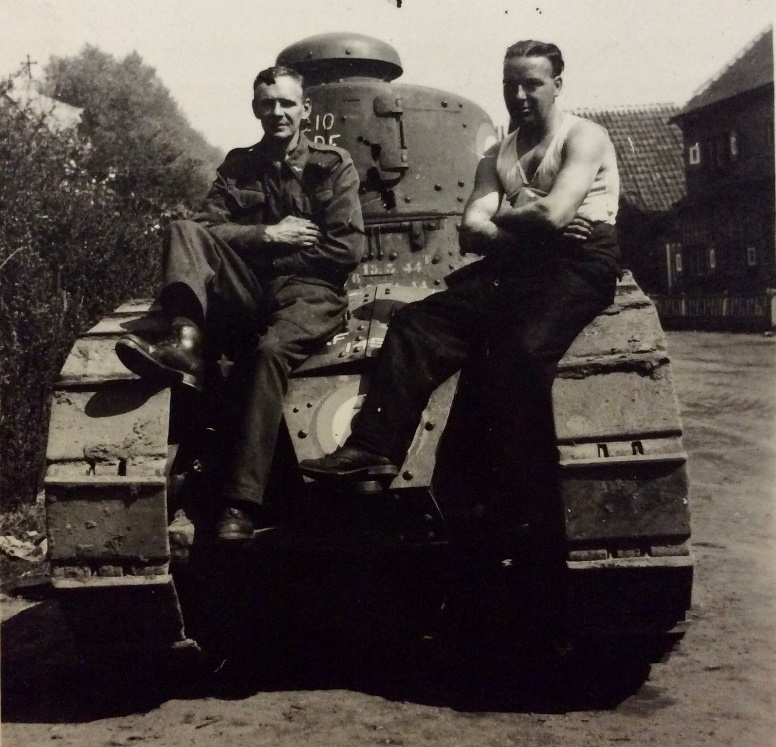
November 1944 - A captured enemy Renault mini tank was used to push and pull a heavy roller over unchecked areas between the mine belts which had already been located and cleared. Cpl Denton volunteered to drive the tank and continued to do so for several days. Although no anti-tank mines were functioned by the tank, he was fully aware of the risk of serious injuries or death. (Cpl. Denton received the BEM for this and other work in NE Europe). Source: family of Cpl Roy Tull
9th November 1944
Additional RAF BD personnel from 6210 Flight arrived in Knokke. They were initially billeted in tents on the airfield and then in ‘deloused’ (buildings cleared of booby traps and bombs) accommodation in Knokke. On their first sortie onto B-83 they discovered a dummy minefield.
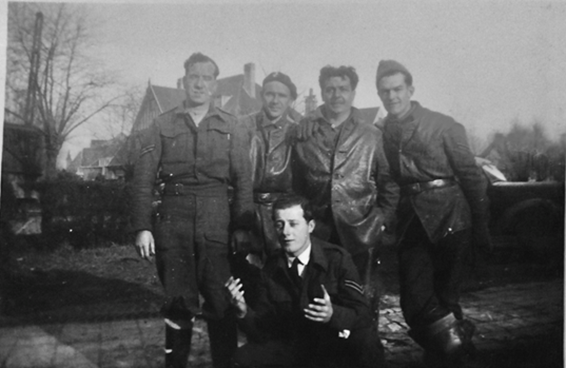
Some of the best friends a chap could wish for, anywhere. 6210 Flight. Taken outside our hotel at Zoute, Knocke, Belgium, 1944. Left to right on the photo in the background – Cpl Francis Battersby BEM, Cpl Stan Connolly BEM, Cpl George Rose BEM, Cpl Roy Tull and unknown airman kneeling in front. Source: Family of Cpl Roy Tull
11th November 1944
Cpl Roy Tull and twelve members of the RAF bomb disposal squad attended the Knokke Remembrance parade along with a contingent of twelve Royal Engineers (REs). In the previous three or four days thirteen RAF men had been blown up by mines and booby traps. Three or four of these were injured when the lorry they were travelling in to reach the airfield, ‘went along the wrong road’, and hit a mine. The driver, Cpl George Telford, was killed.
13th November 1944
High wind and rain all day on ALG B-83. Demining continued with the men probing every inch on their ‘strip’ for wooden box mines and others which the mine detectors couldn’t pick up.
23rd December 1944
Cpl Denton badly injured, two others not so seriously.
25th December 1944
German raid on the airfield – machine guns and bombs on the runway but damage was minimal.
26th December 1944
Cpl Tull noted that 14,000 mines collected so far. The British Royal Engineers working in the area had suffered 40 casualties. Two men from the RAF Wing were badly injured – one picked up a booby-trapped revolver and the other operated a loaded bazooka.
German paratroopers landed nearby but not all of them were caught. RAF Wing had to carry loaded guns at night. The airfield was bombed on the previous night – two hits on the runway but otherwise not a lot of damage.
31st December 1944
‘S’ mine blew up on Hildegard minefield, badly injured two men and another injured not so badly (Jack Denton, Jimmy Leatherbarrow and Chapman).
1st January 1945
Messerschmitts flew over ALG-B83 on reconnaissance at breakfast time. About 09:45 about twelve of them returned and machine gunned the airfield. Ak Ak ( Anti aircraft gun) managed to knock down two and another damaged. There were three air attacks by the Germans after Christmas, but minimal damage was done to the airfield.
6th January 1945
Cpl ‘Bat’ Battersby was killed on the minefield and Cpl Jerry Shearman (on the edge of the airfield) had his right eye blinded by shrapnel. ‘Garry’ Garred, standing behind Bat was deafened but sustained no other injuries.
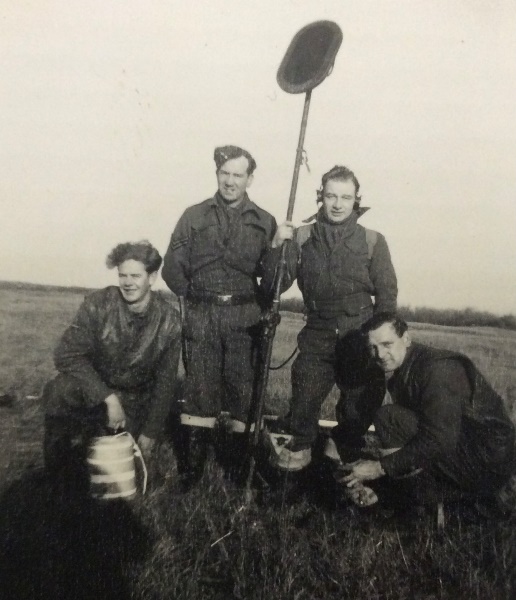
Cpl Battersby 2nd from left and Cpl Denton is kneeling down on the right hand side. Source: Family of Cpl Roy Tull
16th January 1945
Cpl Evans (Taffy) killed by a Box mine.
24th – 26th January 1945
Lorry loads of shells were shipped to the Belgium Army Dump at Eecloo on these days, for disposal.
29th January
Sgt James and another Cpl. recovered the body of a woman from the minefield. There was a layer of four inches of snow at the time and the ground was frozen to a depth of seven inches, which meant they were unable to probe for mines. Nine mines were, however, located along the path they took, and three others were a few inches from the woman.
There was just sufficient room to lift her clear and carry her back along the same path. Unfortunately, the woman was dead when they reached her. (Sgt. James received the BEM for his actions). The name of the woman was Mrs Barbara Stockx, age 61.
31st January 1945
2 x 50 kg SD bombs were destroyed by electrical demolition on Flight demolition site at Knokke.
8th February 1945
F/Lt Booth (6210 sqn) visited ALG B-83 where 39 x 32cm enemy incendiary rocket projectiles were destroyed (Incident 6210/319). The work of moving enemy munitions from store houses at Knokke to Eecloo continued.
Work on sweeping ‘Minerva’ minefield proceeded satisfactorily. (source: 6210 Sqdn Operations Record Book)
18th February 1945
Photo Flash (flash bomb to create an extremely bright flash of light) demolished at Knokke. (Incident 6210 322)
26th February 1945
Wing checkup for deserters – all confined to barracks. Five ‘Gerrys’ caught in khaki.
Cpls Rose and Rigby collected sundry enemy munitions from 424 R & R Ursal and conveyed them to Knokke for demolition.
Sqn/Ldr Scamell (C.O. 6210 Sqdn) and F/LT Booth visited Knokke. Small area still to be swept on airfield and two mines unaccounted for. The two men also visited the British Army Royal Engineers’ school museum, sited on the airfield.
Corporals Rose and Rigby collected sundry enemy munitions from 424 R & R Ursal and conveyed them to Knokke for demolition.
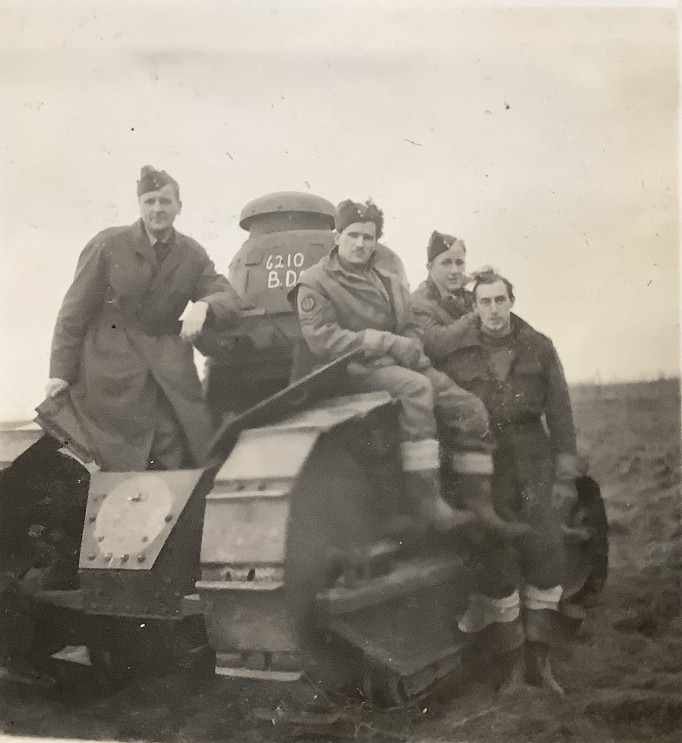
Flight Lieutenant Booth MBE (commanding 6210 Flight on the airfield) standing on the left hand side of the tank . Next to him is Cpl Rose, Cpl Danby and Sgt Empett standing on the far right. Source: Vafadari family
27th February 1945
Various enemy munitions were removed by Sgt Canary and Cpls Rose and Rigby from 425 R & R at Maldegem to Knokke. A 23cm HE rocket projectile was defused by Sgt Canary.
Sgt Empett’s report on completion of work at Knokke Airfield (ALB-83):
Sgt. Empett, with Cpls Rigby, Baldwin & Potter, L.A.c.s Read, Friend and Garred proceeded on attachment to Knokke Airfield. Work was commenced on clearing two storehouses of enemy munitions which were removed to the Belgium Army Munition Dump at Eecloo.
Approximately 70 tons of assorted enemy stores were moved by a vehicle of this flight and one supplied by 313 S.T.C. Notice boards were erected in what was Walburga minefield stating it had been checked for mines and a plan prepared by L.A.C. Read showing area of Minerva minefield still unswept. 54 x 36 cm incendiary rockets previously removed from the airfield were destroyed and 36 x 28 cm H.E. rocket projectiles were taken to the Belgian Dump at Eeclo. Two unfinished mine panels were closed by barbed wire in Agnes minefield and the area taped with mine marking tape.
Mine boards were also erected outside the barbed wire. This work was completed by 5.2.45 when Cpls Rigby and Baldwin returned to Flight H.Q., Cpls Williamson and Connolly replacing them. Sweeping was commenced on the unfinished portions of Minerva minefield. 14 mines were found and neutralized but not lifted. These, along with 6 mines previously found were demolished in situ. (Appendix A, relating to event dated 3.3.45 of 6210 (BD) Flight, Operations Record Book, Summary of Events)
By March 1945 bomb disposal clearance on the airfield was completed and ALG-B-83 was operational with three runways open, following a visit from the RAF ACS (Airfield Construction Squadron). However, the site continued to be used by the RAF for disposal of enemy and unstable Allied munitions, as the Operations Record Book Summaries for 6210 (BD) Flight show.
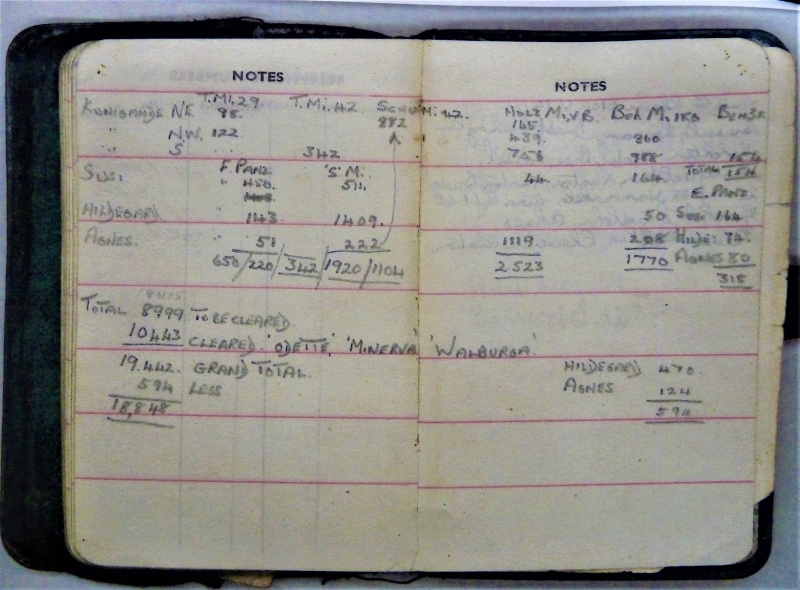
Cpl Tull’s record of munitions collected during the operation on ALG B-83 and along the German Atlantikwall defences in Knokke – a total of 18,848. Source: Family of Cpl Roy Tull
3rd March 1945
Sgt Empett and Cpls Rigby, Baldwin, Connolly and Potter and LACs Read, Friend and Garred returned from operations at Knokke (m/r C932:58).
7th March 1945
W/O Dyer and party proceeded to Knokke on demolition. An assortment of enemy and unviable allied munitions was destroyed.
8th March 1945
Two V.I. warheads were removed from Knokke to Brussels for demolition by 6206 BD Flight.
20th April 1945
Sgt Canary, Cpls Rigby and Brown, LACs Davies and Kitching proceeded on attachment to 142 Wing, Knokke to clear enemy set ground munitions on section of the beach required for recreational purposes. The party worked in conjunction with the bomb disposal section of 142 Wing.
20-26th April 1945
22 large calibre shells and 62 Teller mines were removed from various types of obstacles laid by the enemy as anti-landing devices along the Knokke coastline.
11 German and British anti-aircraft shells were also removed and demolished along with the other munitions. On completion of the work the party returned to Flight HQ.
RAF 142 Wing were operational in NE Europe over the winter of 1944/5 and the bomb disposal team working at ALG B-83 were attached to that unit. There is some evidence that they may have been flying coastal patrols once the airfield became operational in March 1945, as mentioned in Cpl Roy Tull's diary.
RAF Coastal Command were, at this time, flying anti-shipping patrols particularly against German mini-submarines and some of these activities are mentioned in Cpl Tull’s diary.
British Empire Medals were subsequently awarded to five RAF men for their mine clearance and bomb disposal work in Knokke: Cpls Corporals Denton, Rose and Connolly and also Leading Aircraftsmen Garred and Read. RAF 119 Squadron, flying Fairey Swordfish, and 290 Squadron were among the units that used the airfield after Liberation (Traces of War website).
Casualties
There were remarkably few casualties within the RAF Flights working on the airfield given the unstable, dangerous nature of the munitions they were working with.
There was one remarkable near miss when Corporal Connelly’s mine detector touched the igniter of an ‘S’ mine – throwing himself flat on the ground, he watched the mine ejecting into the air, but luckily it did not explode.
The following information relates to British army Royal Engineers who were also working at ALG B-83.
British army Royal Engineers were also dealing with ordnance in Knokke and, in addition, were operating an RE Training School in Knokke whilst the RAF were there. They provided bomb disposal engineer training to members of the Allied forces since the 21 Army Group had been on the Continent.
Major FTK Wilson was Commander and Chief Instructor of the RE Training School: he was subsequently awarded both the Belgian Chevalier of the Order of Leopold II with palm, as well as the Croix de Guerre 1940 with palm for, "helping Belgium Engr Tps and other arms to become proficient in all the subjects covered".
19th January 1946
Half of British Royal Engineers 226BD section attached to 21st Army Group RE Training School, Knokke for emptying mines of explosives. RE reported that approximately 5,000 mines of all types have to be treated, boiling method to be used. Finished 20th February – number of mines treated 2,300.23rd January 1946
RE 226 BD rejoined section on bomb disposal work in the Brussels area.
28th March 1946
Half of British Army 226 BD section transferred to the 21 Army Group RE School, Knokke. Authority CE l of C to empty 700 enemy mines for training purposes.
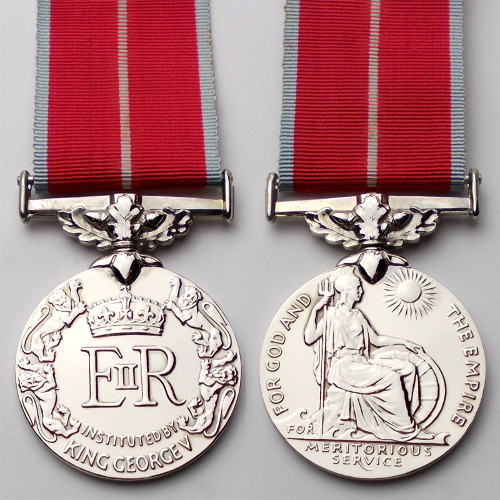
British Empire Medal (BEM) - The British Empire Medal is granted in recognition of meritorious civil or military service. Source: Wikipedia
RAF Airman awarded the BEM for gallantry 1944 – 1945
All the men listed here were involved in clearing explosives from houses, hotels and specially in the mine clearance of the airfield at Knokke 't Zoute also known as ALG B-83 and its immediate vicinity. For the risky work and the courage and task awareness they displayed they received the British Empire Medal (BEM). The list below contains the names as they appeared in the London Gazette in 1944 and 1945.
| Francis Battersby, 1277445 Corporal Royal Air Force Volunteer Reserve (since deceased) |
Corporal Battersby took charge of the remaining members of his party, after the explosion of a charge which was detonated by the fouling of a concealed trip wire, until the arrival of his Flight Commander. Corporal Battersby was required to continue this form of work after casualties had occurred among his party. He has displayed high courage and leadership. London Gazette - 23 March 1945 |
| Stanley Arthur John Connolly, 1276335 Corporal Royal Air Force Volunteer Reserve | One day, during the clearance of mines and booby traps from six 'hotels in Blankenberghe, a trip wire was fouled and three of his section were badly injured. Immediately after the casualties had been evacuated Corporal Connolly continued with his hazardous work, which was completed five days later. Corporal Connolly's example and personal bravery, shown throughout the operations, have been an inspiration to all. London Gazette – 27 April 1945 |
| Jack Raymond Denton, 929828 Corporal Royal Air Force |
In November, 1944, a captured enemy tank was used to push and pull a heavy roller over unchecked areas between the mine belts. Corporal Denton, fully aware of the risk of serious injuries or death, volunteered to drive the tank and continued to do so for several days London Gazette – 27 April 1945 |
| George Henry Rose, 958613 Corporal Royal Air Force | Corporal Rose rendered first aid after the exploison of an "S" mine exploded, causing 5 casualties including the flight commander. He did not hesitate to continue his hazardous duties in a courageous and efficient manner, thereby setting an example to his comrades. London Gazette – 27 April 1945 |
| Roland Norman Garred 805558 Leading Aircraftman Royal Air Force Volunteer Reserve |
Roland Norman Garred has been outstanding amongst about 25 airmen below the rank of corporal who have been engaged on the minefield and they have never hesitated to perform work far beyond that which could be expected of them in view of their classification and training. They have shown keenness and courage on work of a hazardous nature and have contributed much to the success which has been achieved. London Gazette – 27 April 1945 |
| Samuel William Read, 1666507 Leading Aircraftman Royal Air Force Volunteer Reserve |
Samuel William Read has been outstanding amongst about 25 airmen below the rank of corporal who have been engaged on the minefield and they have never hesitated to perform work far beyond that which could be expected of them in view of their classification and training. They have shown keenness and courage on work of a hazardous nature and have contributed much to the success which has been achieved. London Gazette – 27 April 1945 |
| Laurence Vincent James, 814914 Sergeant Royal Air Force Volunteer Reserve | Sergeant Vincent recovered,in January, 1945, the body of a woman from a minefield. She was in the midst of 12 mines. The dangerous work. to lift her clear and carry her back, was coolly and cleverly performed and is only one instances of the courage and fortitude displayed by Sergeant Vincent. London Gazette – 14 August 1945 |
| Edmund Robert Cox Melville, 1556525 Corporal Royal Air Force Volunteer Reserve | Corporal Melville had a narrow escape and suffered from shock, after an "S" mine exploded within ten yards of him. Corporal Melville was ready, when called upon, to continue his hazardous duties. Corporal Melville is an exceptional courageous and determined worker and is completely unperturbed by any of the disturbing circumstances which frequently arise in the course of his hazardous work. London Gazette – 27 April 1945 |
| William Henry Morris, 1173558 Corporal Royal Air Force Volunteer Reserve | Corporals Reid and Morris worked together as a team, the former detecting and the latter neutralising mines. Each has shown the greatest confidence in the ability of the other and their work contributed largely to the successful disposal of many anti-tank mines. They both showed exceptional skill, courage and leadership in dangerous circumstances. London Gazette – 27 April 1945 |
| William Kelly Reid, 998304 Corporal Royal Air Force | Corporals Reid and Morris worked together as a team, the former detecting and the latter neutralising mines. Each has shown the greatest confidence in the ability of the other and their work contributed largely to the successful disposal of many anti-tank mines. They both showed exceptional skill, courage and leadership in dangerous circumstances. London Gazette – 27 April 1945 |
*See also: Former-Airfield-Knokke-Le-Zoute*
Afterword
Sources for this document have been collated by Barbara Kelly (nee Tull), daughter of Cpl/Sgt Roy Tull, 5139/6210 Flight, 142 Wing.
Information has mostly been gathered from personal diaries (Cpl Roy Tull’s diaries and photographs with reference to LAC ‘Garry’ Garrard’s diaries where appropriate).
References to RAF operations in the Knokke area were also found in the the RAF 6210 (BD) Flight Operations Book (RAF Form 540) at the Imperial War Museum. the RAF Association the BBC WW2 People’s War archive, the RAF Historical Journal and Eddy Lambrecht (Knokke-Heist in WO2: Atlantikwall en Bezetting´).
Also many thanks to the daughter and granddaughter of Squadron Leader Scamell (the Vafadari family) for their contribution.
Particular thanks to Chris Randsted (Archivist for the RAF Bomb Disposal Association).
Last, but not least, many thanks to Danny and Freddy Jones of the remarkable For Freedom Museum in Ramskapelle, near Knokke for their inspirational support and assistance in research.
Definitielijst
- bazooka
- American antitank rocket launcher weapon. Rocket with shaped charge is put in a long tube which is electrically fired from the shoulder of an infantry man. The bazooka can be reloaded. The bazooka produces a large flame to the rear which makes it unsuitable for fighting from closed compartments or from homes. British counterpart is the PIAT, Projector Infantry, Anti- Tank, also a man-portable anti-tank weapon. Germany used Panzerfaust and Panzerschreck, “armour fist “ and “armour terror”.
- mine
- An object filled with explosives, equipped with detonator which is activated by either remote control or by colliding with the targeted object. Mines are intended to destroy of damage vehicles, aircrafts or vessels, or to injure, kill or otherwise putting staff out of action. It is also possible to deny enemy access of a specific area by laying mines.
- paratroopers
- Airborne Division. Military specialized in parachute landings.
- RAF
- Royal Air Force. British air force
- raid
- Fast military raid in enemy territory
- rocket
- A projectile propelled by a rearward facing series of explosions.
- Squadron
- A military unit in the Belgian navy usually six to eight small ships operating together under one command. The smallest military unit in the Dutch air force of about 350 men. In most countries is the designation of a military unit thesize of a company. It is either an independent unit, such as a battery, or part of a bigger Calvary unit. In the air force it is the designation of a unit of aircrafts.
Information
- Published by:
- Leo G. Lensen
- Published on:
- 29-08-2022
- Last edit on:
- 18-09-2022
- Feedback?
- Send it!
